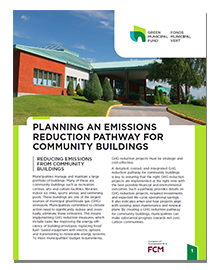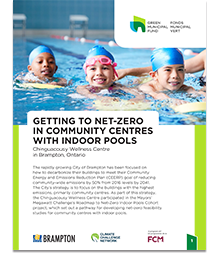Our Community Buildings Retrofit initiative is dedicated to assisting small and rural communities and municipalities in enhancing the sustainability and energy efficiency of their existing public facilities and structures by completing building retrofits.
Within this factsheet page, you will find informative resources designed to guide you through the process of successful retrofit and energy management projects. These resources offer valuable insights into the numerous advantages that these projects bring, including increased affordability, reduced greenhouse gas (GHG) emissions, and an improved quality of life for the community members who utilize these buildings. If you seek to optimize the energy efficiency of your current community structures, our resources will provide essential information to help you meet your performance goals.
Planning an emissions reduction pathway for community buildings
Discover how planning an emissions reduction pathway for your community buildings is essential for achieving climate goals within budget constraints. Municipalities manage a vast portfolio of community structures that significantly contribute to GHG emissions. By implementing targeted GHG reduction measures, like enhancing energy efficiency and adopting renewable energy solutions, you can align your climate action objectives with your financial realities.
Explore the diverse benefits of GHG reduction pathways, from long-term planning and climate accountability to financial efficiency and interdepartmental collaboration. Our tailored roadmap outlines five actionable steps, from building selection to feasibility studies, to help you succeed. Real-world success stories show you how other municipalities have achieved remarkable emissions reductions and cost-effective investments, inspiring you to take meaningful action.
Supporting new energy and climate staff
Dive into our short guide to learn more about how Canadian municipalities can better support new staff with effective onboarding and training that will eliminate decision-making delays and inefficiencies in the implementation of their energy and climate programs.
To ensure new hires can quickly become productive members of the department, they need to be equipped with the proper knowledge, skills, and relationships. Our guide is packed with strategies, from succession planning to knowledge retention, as well as key steps for a successful onboarding process that will help your team thrive. It also provides examples of leading professional development and networking opportunities to encourage continuous learning and skill development for all staff.
Getting to net-zero in community centres with indoor swimming pools
Chinguacousy Wellness Centre in Brampton, Ontario
The City of Brampton is focusing on decarbonizing its most energy-intensive buildings to reach its goal of reducing community-wide emissions by 50% from 2016 levels by 2041. As part of this strategy, the Chinguacousy Wellness Centre—a 25-year-old building with three indoor swimming pools—conducted a net-zero feasibility study to plan the way forward. The study identified two potential low-carbon scenarios: deep retrofits to aggressively reduce GHG emissions and immediate low-cost measures without retrofits.
Discover results from this study and important recommendations provided by Junaid-Saleem Khan, Supervisor, Energy Management, City of Brampton.
Achieving energy and carbon reduction in community buildings through asset management plans
Asset management plans help local governments construct, maintain and dispose of municipal infrastructure assets while minimizing risk and cost to the community and maximizing service delivery. They also provide a strategic opportunity to support energy and carbon reduction goals.
This guide aims to give Canadian municipalities a better understanding of asset management planning, including the benefits of integrating energy and carbon reduction into asset management planning, the first steps in achieving this, and a list of resources.
Measurement and verification for energy-efficient community buildings
To ensure that energy-saving measures and building operations are achieving their intended energy-efficiency targets, well-executed measurement and verification (M&V) is crucial.
This guide introduces the M&V process, explains the benefits of a robust M&V plan, provides key steps of the process and provides additional M&V resources.
Featured resources
Guide: Taking your indoor ice rink to net zero
Learn how to develop an actionable roadmap to net zero ice rinks
Read moreGuide: Taking your indoor swimming pool to net zero
Key measures and lessons learned to help you build a net-zero plan
Read moreGuides: Equity and non-energy benefits of community building retrofits
Explore how retrofits can build more equitable and resilient municipalities.
Read more





